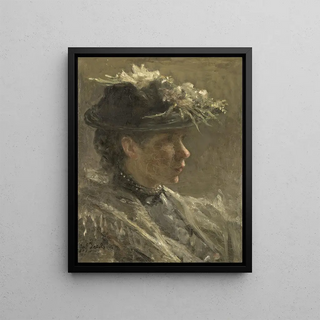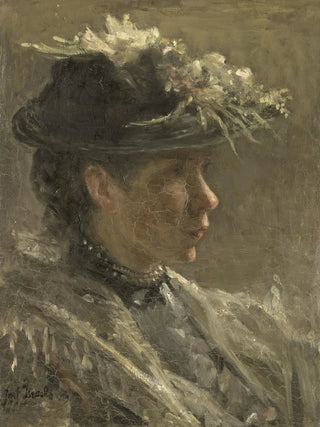Art print | Study of Sijtje van Bemmel 1880-1963 - Jozef Israëls Source: Reproduction | Étude de Sijtje van Bemmel 1880-1963 - Jozef Israëls


View from behind

Frame (optional)
In the world of art, some works manage to capture the very essence of humanity through striking portraits. "Study of Sijtje van Bemmel 1880-1963" by Jozef Israëls is one of those creations that transcend the mere frame to offer a glimpse into the soul of its subject. This piece, crafted by a master of Dutch realism, evokes not only the beauty of the subject but also a profound reflection on life and the passage of time. Through this study, Israëls invites us to contemplate the dignity and depth of human emotions, while immersing us in a rich and evocative artistic universe.
Style and uniqueness of the work
Jozef Israëls' style is characterized by an intimate approach and meticulous attention to detail. In "Study of Sijtje van Bemmel," light plays a leading role, illuminating the face of the model in a way that seems almost supernatural. The delicate nuances of the skin, subtle shadows, and reflections in the eyes reveal a mastered technique that demonstrates a deep respect for the human figure. Every brushstroke appears to be charged with intention, emotion, transforming the portrait into a true window to the soul. The composition is both simple and powerful, allowing the viewer to connect directly with the subject. This work embodies a harmony between realistic representation and artistic sensitivity that gives it an undeniable singularity.
The artist and his influence
Jozef Israëls, born in 1824, is one of the pillars of The Hague School, a movement that profoundly influenced Dutch art in the 19th century. His career, marked by exhibitions and distinctions, testifies to his commitment to depicting everyday life and modest characters. Israëls succeeded in establishing himself through his ability to capture the nuances of the human condition, while drawing inspiration from old masters. His influence extends well beyond his era, inspiring many artists to explore similar themes. Through his work, he paved the way for a more introspective approach

Matte finish

View from behind

Frame (optional)
In the world of art, some works manage to capture the very essence of humanity through striking portraits. "Study of Sijtje van Bemmel 1880-1963" by Jozef Israëls is one of those creations that transcend the mere frame to offer a glimpse into the soul of its subject. This piece, crafted by a master of Dutch realism, evokes not only the beauty of the subject but also a profound reflection on life and the passage of time. Through this study, Israëls invites us to contemplate the dignity and depth of human emotions, while immersing us in a rich and evocative artistic universe.
Style and uniqueness of the work
Jozef Israëls' style is characterized by an intimate approach and meticulous attention to detail. In "Study of Sijtje van Bemmel," light plays a leading role, illuminating the face of the model in a way that seems almost supernatural. The delicate nuances of the skin, subtle shadows, and reflections in the eyes reveal a mastered technique that demonstrates a deep respect for the human figure. Every brushstroke appears to be charged with intention, emotion, transforming the portrait into a true window to the soul. The composition is both simple and powerful, allowing the viewer to connect directly with the subject. This work embodies a harmony between realistic representation and artistic sensitivity that gives it an undeniable singularity.
The artist and his influence
Jozef Israëls, born in 1824, is one of the pillars of The Hague School, a movement that profoundly influenced Dutch art in the 19th century. His career, marked by exhibitions and distinctions, testifies to his commitment to depicting everyday life and modest characters. Israëls succeeded in establishing himself through his ability to capture the nuances of the human condition, while drawing inspiration from old masters. His influence extends well beyond his era, inspiring many artists to explore similar themes. Through his work, he paved the way for a more introspective approach






